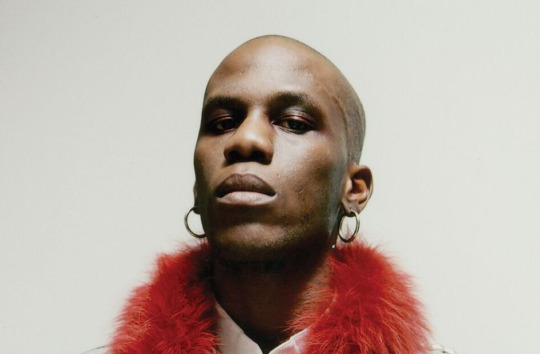#need to loop this song for nine years and imagine scenarios ...
Explore tagged Tumblr posts
Text
i just think Nothing's New by rio romeo could be a mine song
#snap chats#someone's raising a tomato but hear me out#i jiust think......... //vague gesturing//#i just lke it when mine can't totally be secure with oother people .... just always having this sinking feelni in the back of his mind#he'll still give his all because That's What He Does but i lke it when he's still cynical in the back of my mind ....#daigo wouldnt leave you bb ...... should he Thats A Topic For Debate but he loved you to the end and even beyond bro...#anyway no one look at me i made myself depressed BYE#need to loop this song for nine years and imagine scenarios ...
4 notes
·
View notes
Text
Top 25 Songs of 2018: Honorable Mentions

It’s year-end list season again! And with that comes my sixth annual top 25 list.
But before we countdown the best that 2018 gave us, here’s 15 songs that just missed the cut. Like in 2017, this year had more quantity than quality when it came to singles, meaning although there were only a couple legitimate contenders for the top spot, there were plenty of solid songs that I had to give a shout out to. So apologies to great acts like boygenius, Florence+The Machine and Childish Gambino (although he easily had the best music video this year) for just missing the cut.
Let’s get into it!

“Nobody” by Mitski
There are plenty of songs about loneliness, but Mitski turns that emotion into insanity on “Nobody.”
Her emotions ramp up and become more desperate throughout the indie-pop track, as Mitski’s pleads for companionship intensify. She wants to find love, but frankly, she also just needs human connection. And as the one-word chorus repeats into oblivion — “Nobody, nobody, nobody, nobody...” the situation becomes more and more helpless.
My main issue with Mitski’s 2018 album, Be The Cowboy, was that most of the short vignette-style songs weren’t memorable. That’s not the case for the manic, disco-tinged “Nobody,” which instantly became a standout in her impressive catalog.

“Heat Wave” by Snail Mail
I’m not sure what it says about indie rock that its most hyped newcomer is mostly copying the sounds of the ‘90s, but when the tunes are as good as “Heat Wave,” I’m not going to complain.
Nineteen-year-old prodigy Lindsey Jordan, aka Snail Mail, delivers with a simple love song perfect for lazy summer days. Jordan’s vocals are charmingly warbly and mesh well with the crunchy guitars that wouldn’t sound out of place on a Pavement album. It’s catchy enough for soccer moms and with enough alt-rock nostalgia to grab any indie rocker’s ear. There’s a good reason Snail Mail’s star has shot to the top this year among the Pitchfork set.

“Me and Michael” by MGMT
IT’S THE COMEBACK OF THE CENTURY!
That’s not even hyperbole: After they released three generation-defining classic singles, MGMT’s relevance disappeared after their 2010 album Congratulations intentionally alienated audiences (despite being pretty solid). Then, their 2013 self-titled album was straight-up bad.
But thankfully, MGMT decided to return to the synthpop jams that brought them success 11 years ago, while keeping their weirdo quirks intact. And it was a winning formula, as the bombastic single “Me and Michael” proves.
“Michael” is painfully ‘80s, from the glittery keyboards to the thundering drum machine beat. Yet, many of the instruments are off-key and frontman Andrew VanWyngarden’s hipstery vocals aren’t exactly Duran Duran-esque. And the clash of styles helps create a solid tune, the band’s best in eight years.

“Elastic” by Joey Purp
Remember how Azealia Banks used to pump out hip-house bangers like it wasn’t even hard? Then she lost her mind, and now “212″ is a relic of a better time.
Thankfully, Chicago native Joey Purp is picking up the slack, although he puts a much more minimalist spin on the sound. “Elastic” is a very simple, skeletal song, with Purp nearly mumbling over a steady, bouncing beat with couple vocal samples to liven things up. “Elastic” shows that when it comes to club bangers, you really don’t need to overthink things.

“Nameless, Faceless” by Courtney Barnett
Melbourne indie rocker Courtney Barnett’s second album, Tell Me How You Really Feel, had a noticeably more frustrated outlook than her 2015 debut. A prime example is the album’s lead single, “Nameless, Faceless,” all about the difficulties of being a woman in a world that treats them horribly.
Barnett goes after internet trolls during the song’s verses with the droll, snarky tone that made her indie-famous, but the chorus is where things take a dark turn. Paraphrasing The Handmaid’s Tale author Margaret Atwood, Barnett sings, “Men are scared that women will laugh at them ... Women are scared that men will kill them.” She then adds that she holds her keys between her fingers in-between her fingers to protect herself at night.
It’s a fearful song for fearful times, and more proof that Barnett is one of indie rock’s best songwriters.

“Electricity” by Silk City and Dua Lipa
Producer giants Diplo and Mark Ronson teamed up to create a perfect homage to ‘90s house. It’s bouncy, effervescent, and features one of pop’s best voices: Dua Lipa. The fact that a dance jam this perfect was only barely a hit in the U.S. is a total shame.

“After The Storm” by Kali Uchis feat. Tyler, The Creator and Bootsy Collins
I’m not typically an R&B guy, but I couldn’t resist newcomer Kali Uchis’ debut Isolation this year, especially its smooth throwback single, “After The Storm.”
Uchis glides over the off-key synth backdrop, expressing post-breakup optimism with ease. The sticky melody and relaxed vibe are helped out by a blast of smooth (if off-kilter) loverman shtick from Tyler, The Creator and some fun adlibs from funk icon Bootsy Collins. But this is Uchis’ show, and she barely needs to lift a finger to hold listeners’ command.

“Please Don’t Die” by Father John Misty
After releasing an overstuffed and underwhelming album last year, Father John Misty, AKA singer-songwriter Josh Tillman, decided to keep it simple this year, and I’m back on his bandwagon.
One reason for that is how blunt and personal his songwriting is again, particularly on “Please Don’t Die.” Tillman’s concept album God’s Favorite Customer focuses on the real-life story of how his depression caused him to hide out in a hotel for two straight months, and the heartbreaking “Please Don’t Die” tackles this scenario from the singer’s wife’s point of view.
She constantly reminds Tillman that his potential suicide won’t be a victimless crime during the soaring chorus, and he laments how his spiraling has affected her in the somber verses. There’s no snarky winks to the audience here — just Tillman nakedly depicting how his emotional chaos effected those around him.

“My My My!” by Troye Sivan
I never paid too much attention to Australian former YouTuber Troye Sivan. Now I’m regretting that choice, thanks to “My My My!”
Pure bubblegum pop doesn’t play much of a role in today’s music landscape, so it’s hard to call any version of that subgenre “modern,” but that’s honestly how I would describe this jam. It’s a slice of stuttering tropical pop with some indie and ‘80s flavor to it, and Sivan himself sells the tune like he’d been singing these types of songs for years in a boy band. I’ll be keeping tabs on Sivan from here on out.

“Light On” by Maggie Rogers
Last year, I was floored by Maggie Rogers’ unique blend of rootsy nature sounds with blue-eyed soul, particularly in her stellar single “Dog Years.” It seems like she isn’t fixing what ain’t broken, as “Light On” is a continuation of that sound.
Although it isn’t quite as transcendent as her early singles, “Light On” is still a quality power ballad, with a nice mix of acoustic guitar and organic synths, complete with a showstopping, melancholy chorus. Rogers still knows her way around a gorgeous melody, and I’m sure she’ll continue to fill her niche as the best music you’ll probably hear at REI.

“The Opener” by Camp Cope
Camp Cope have had it up to here with shitty men, and “The Opener” is a scathing indictment of the hypocrisy the trio constantly face.
Lead singer Georgia McDonald wails over a ‘90s alt-rock groove about sexism both in the dating world as well as the music industry. The latter is where she reserves her sharpest lines, going after men who’ve said her success isn’t her own doing, and being told to book smaller venues by the same guys who will “preach equality” in public. And of course, how do these men in power maintain their faux-feminist image? “‘Just get a female opener, that’ll fill the quota.’” Scathing.

“We Appreciate Power” by Grimes feat. HANA
If “We Appreciate Power,” the (as of writing this) brand-new Grimes single, was trimmed by a minute or so, it might have made the actual list. It’s a smidge on the repetitive side at its current 5:30-length.
But dear lord: This is a BANGER. As just about every critic has said, the production here is an aggro mix of Nine Inch Nails and Korn, complete with squealing guitars, a pounding, synthetic beat and some random screams thrown in the mix for fun. And yes — it works. Put it on during the next workout and see how fast you start going.
Throw in some legitimately creepy lyrics about artificial intelligence and totalitarianism and you’ve got a classic Grimes single. If only it was a bit shorter...

“Lake Erie” by Wild Pink
For a band from Brooklyn, Wild Pink are shockingly good at creating music that sounds like the sun setting on a Midwestern corn field.
“Lake Erie” is so close to The War On Drugs’ signature sound — heartland rock mixed with whispered vocals and shoegaze-y atmospherics — that I’d call it a ripoff, if it wasn’t arguably better than anything The War On Drugs has put out in a few years. It’s emotive, gorgeous and not too pretentious, like something Bruce Springsteen could’ve released 35 years ago.

“Noid” by Yves Tumor
No, unfortunately, “Noid” isn’t about retro Domino’s ads. It’s much darker than a claymation pizza mascot.
Yves Tumor’s art-rock track is fairly normal for its first half. It even has shades of Marvin Gaye’s “What’s Going On” in the lyrics wondering about the sad state of the world. Then, things get weird: the bass starts playing in a different key, the background fills with static and screams, and Yves Tumor keeps singing along, and his lyrics about being “scared for my life” start to seem less like a protest anthem and more like a horror soundtrack. It’s a chilling experience.

“Party For One” by Carly Rae Jepsen
Queen Carly releases another pop banger and you think it’s not going on my list? Come on, now.
I’m not going to pretend like “Party For One,” Jepsen’s triumphant breakup anthem, is on the same level as her all-time classic singles. It’s the kind of bubblegum that she could write in her sleep.
But why penalize a perfectly great song just because the artist has done better in the past? “Party For One” might not be “Run Away With Me,” but it’s still a solid piece of synth cheese that no doubt makes Canada proud.
3 notes
·
View notes
Note
Do you have any tips for journaling for anxiety without spiraling or just “complaining on paper”? It helps a bit when I write like that, but it usually makes me feel worse after a while.
Hmm, that's a good question, because "complaining on paper" pretty accurately describes most of the journaling I do. I personally tend to get trapped in a loop when I'm experiencing strong emotions, and putting that feeling into words helps me break through it and move past that thought -- something about the linearity of writing it down and explaining it!
Have you tried reframing or thought-stopping? There's a handful of CBT techniques that deal with anxious thoughts, and maybe following up the record of your anxiety with some of those might help. One of the cool things about CBT is that you don't have to believe wholeheartedly in what you write or think -- it just helps to say that thing out loud or on paper, and over time can decrease the intensity of the original negative thought. So you could briefly note down the thought you're having, but then write down a couple of other ways of looking at it, even if that doesn't feel as real to you as the anxiety thought.
For example, one of the things I find really helpful when I'm spiraling or catastrophizing is the "worst case/best case/most likely case" thing. My anxiety's really good at making me think of the worst-case scenario, but then I try to imagine what the best-case scenario might look like instead. And the truth is that neither of those is going to be 100% accurate, so the most likely case is something in between those. My brain says, "you've been late to work three times this week, your boss is going to fire you," and I can say back, "or maybe he hasn't noticed and doesn't care at all as long as I do my work." In reality, the truth is probably that punctuality is something I could improve at and he'll mention it to me eventually, but isn't the world-ending disaster my anxiety disorder tells me it is because there's a lot of other stuff I do well at my job.
Another option might be that journaling about the anxious thought itself is just dwelling on it and makes it worse for you, so journaling about something else instead might be more helpful for you! You could try countering it by writing down things that have happened in the last week that did make you happy, or a list of your favorite blorbos, or a few song lyrics you really like. You could also prep some ideas for that ahead of time so that next time you're caught up in anxiety you know what things to brainstorm about instead, since you'll probably have difficulty thinking about anything else in the moment.
Does any of that sound like it might help you? I hope so, but feel free to shoot me another ask if you wanna go in a different direction with all this. I've been journaling for eight or nine years now and the way I journal has definitely changed over time. I'm pretty sure I have more ideas up my sleeve if you need 'em!
#anon ask#answered#if you're the same anon that sent the other ask I got that one too!#I'm thinking up answers for it rn
0 notes
Link
Learn why we decorate trees, swap cookies and hide pickles and elves, among other traditions.
From its Puritan roots to complaints of rampant commercialism (“What is it you want?” Charlie Brown asks Lucy in A Charlie Brown Christmas. “Real Estate.”), Christmas in America has been filled with traditions, old and new.
According to a Pew Research Center survey, nine in 10 Americans say they celebrate the holiday, and while it’s true that many Christmas traditions date back to 16th-century Germany or even ancient Greek times, others have caught on just in modern times.
Here’s a look at 25 ways Americans have celebrated the Christmas season, from singing songs and reciting poems to decorating trees and swapping cookies to guzzling eggnog and dressing up in ugly sweaters.
Christmas Trees - Decorated trees date back to Germany in the Middle Ages, with German and other European settlers popularizing Christmas trees in America by the early 19th century. A New York woodsman named Mark Carr is credited with opening the first U.S. Christmas tree lot in 1851. A 2019 survey by the American Christmas Tree Association, predicted that 77 percent of U.S. households would display a Christmas tree in their home. Among those trees on display, an estimated 81 percent were artificial and 19 percent were real.
The Rockettes perform their annual Christmas show at Radio City Music Hall in New York City.
The Rockettes - Since 1925, first known as the Missouri Rockets, this iconic dance troupe has been kicking up its heels, officially becoming the Radio City Music Hall Rockettes in 1934. From performing at movie openings to entertaining troops to making TV appearances, they’re perhaps best-known for their annual Christmas Spectacular.
Charlie Brown's tree in "A Charlie Brown Christmas."
A Charlie Brown Christmas - Decades later, it may be hard to imagine that this beloved TV special inspired by Charles Schulz’s Peanuts comic strip was first rejected by CBS executives. But when it finally aired on December 9, 1965, almost half of all U.S. TV sets were tuned to the broadcast, and the show went on to win an Emmy, a Peabody, an enduring following and even a trend of “Charlie Brown” Christmas trees. “I never thought it was such a bad little tree,” Linus says in the sprecial. “It's not bad at all, really. Maybe it just needs a little love.”
The Christmas pickle is designed to be hard to find.
Christmas Pickles - If there’s a pickle among your snowman, angel and reindeer ornaments, you’re likely taking part in the American tradition of hiding the green ornament on the tree, so that the first child to find it wins a gift, or gets to open the first present Christmas morning. The practice’s origins are a bit murky (or should that be briny?), but, according to Atlas Obscura, it’s likely it grew from a Woolworths marketing gimmick from the late 1800s, when the retailer received imported German ornaments shaped like a pickle and needed a sales pitch.
Elf on the Shelf requires nightly relocation.
Elf on the Shelf - Love it or loathe it, since 2005, moms and dads have either joyously or begrudgingly been hiding a toy elf each night from Thanksgiving to Christmas. More than 13 million elves have been “adopted” since 2005 when Carol Aebersold and her daughter, Chanda Bell, published the book Elf on the Shelf: A Christmas Tradition that comes with the toy. Social media has even inspired some parents to set up elaborate scenarios for their elves—as in: He TP’d the tree! She filled the sink with marshmallows!
Yule logs date back to ancient winter solstice.
Yule Log - Yule logs were part of ancient winter solstice celebrations, but it was Americans who turned the wood burning into must-see TV. Back in 1966, WPIX-TV in New York City aired a continuous 17-second loop of a fireplace for three hours along with holiday music. That led to an eventual better production and nearly 20 years of annual viewing. Today, you can view the yule log on demand, on YouTube and more.
Advent calendars count down the days.
Advent Calendars - Early versions of this tradition, started in Germany in 1903 by publisher Gerhard Land, offered a way for children to count down to Christmas by opening one “door” or “window” a day to reveal a Bible passage, poem or small gift. Since gaining mass popularity by 1920, the calendars have evolved to secular calendars that include daily gifts from mini bottles of wine to nail polish to chocolates to action figures.
Edible gingerbread house.
Gingerbread Houses - Although Queen Elizabeth I gets credit for the early decorating of gingerbread cookies, once again, it’s the Germans who lay claim to starting the gingerbread house tradition. And when the German Brothers Grimm wrote “Hansel and Gretel” a new holiday tradition was born. Today, the edible decorations are available in a slew of pre-packed kits.
In "The Nutcracker," Clara falls for a nutcracker who comes to life.
The Nutcracker - For many, the holiday season is not complete without a trip to watch this ballet. With music by Pyotr Ilyich Tchaikovsky and originally choreographed by Marius Petipa, the romantic tale of the young Clara’s Christmas Eve premiered Dec. 18, 1892, in St. Petersburg, Russia. It was performed for the first time outside of Russia in 1934 in England, and made its way to the United States in 1944 when it was performed by the San Francisco Ballet. It became a must-see event in America in the 1960s, as performances spread across the nation.
The uglier the better.
Ugly Christmas Sweaters - You can blame our neighbors to the north for this silly, ironic tradition that really gained steam in the 1980s. According to the Ugly Christmas Sweater Party Book, the sweaters became a party trend in Vancouver, Canada in 2001. And the trend is seemingly here to stay. According to Fox Business, the ugly sweater industry is a multi-million business, with websites such as Tipsy Elves, retailers including Macy’s, Kohl’s and Target, and even food chains jumping on the ugly bandwagon.
Leaving something for Santa.
Cookies and milk for Santa - While leaving treats for Santa and his reindeer dates back to ancient Norse mythology, Americans began to sweeten up to the tradition during the Great Depression in the 1930s, as a sign of showing gratitude during a time of struggle.
Candy canes date back to the 17th century.
Candy Canes - Whether devoured as a treat or hung on the tree as decoration, candy canes are the No. 1-selling non-chocolate candy during December, and date back to 1670 Germany. The red and white peppermint sticks arrived stateside in 1847, when a German-Swedish immigrant in Wooster, Ohio placed them on a tree. By the 1950s, an automated candy cane-making machine was invented, cementing their mass appeal.
American colonist devised some of the first eggnog recipes.
Boozy Eggnog - Eggs, milk, sugar, rum—nothing makes the holidays happier more quickly than a glass of spiked eggnog. Although the yuletide cocktail stems from posset, a drink made with hot curdled milk and ale or wine from medieval England, American colonists get credit for making it popular and adding rum. Even George Washington had a special recipe.
Door Wreaths - Wreaths have been around since the ancient Greek and Roman times, but the evergreen Christmas wreath, often adorned with boughs of holly, eventually took on Christian meaning, with the circular shape representing eternal life and the holly leaves and berries symbolic of Christ’s crown of thorns and blood, according to the New York Times. Today’s wreaths, which come in all varieties, from flowers and fruit to glass balls and ribbon to artificial and themed, are most often seen as a secular winter tradition.
A Christmas card from the 1800s.
Sending Christmas Cards - The first official Christmas card debuted in 1843 England with the simple message, “A Merry Christmas and a Happy New Year to You.” The idea of a mailed winter holiday greeting gradually caught on in both Britain and the U.S., with the Kansas City-based Hall Brothers (now Hallmark) creating a folded card sold with an envelope in 1915. Today, according to the Greeting Card Association, more than 1.6 billion holiday cards are sold annually.
"It's a Wonderful Life" debuted in 1946.
It’s a Wonderful Life - Frank Capra’s classic Christmas film debuted in 1946, with Jimmy Stewart playing George Bailey, a suicidal man who is shown what life would be like without him by an angel. But before becoming an annual TV-viewing tradition, the movie was a bit of a flop at the box office when it premiered, although it did receive five Oscar nominations (but no wins). A lapsed copyright in the 1970s allowed TV stations to air the movie for free. It has aired exclusively on NBC and USA since 1994.
Christmas Light Technology (TV-PG; 1:53)
Christmas Lights - Thomas Edison may be famous for the light bulb, but it was his partner and friend, Edward Hibberd Johnson, who had the bright idea of stringing bulbs around a Christmas tree in New York in 1882. By 1914, the lights were being mass produced and now some 150 million sets of lights are sold in the U.S. each year.
Santa has helped stores sell since at least 1890.
Department store Santa - Lining up at the mall to snap a photo of the kids on Santa’s lap may seem like a modern Christmas tradition, but it dates back to 1890, when James Edgar of Brockton, Massachusetts had a Santa suit made for him and dressed as the jolly fellow at his dry goods store. The gimmick caught on and a year later Santas could be found in many stores. While many point to Edgar as the original store Santa, Macy’s in New York claims it has been hosting Santa since 1862.
Fruit cake can be eaten—or tossed.
Making Fun of Fruitcake - A favorite of the Brits (both Princess Diana and Kate Middleton served it at their weddings), fruitcake—that much-maligned mix of dried fruit, nuts and brandy—has been the subject of long-running American holiday jokes. Truman Capote wrote a short story about “fruitcake weather” in 1956, the small town of Manitou Springs, Colorado holds an annual Fruitcake Toss Day on January 3, and the dessert has become fodder for many a comedian. For example, in 1985 Johnny Carson cracked, “The worst Christmas gift is fruitcake. There is only one fruitcake in the entire world, and people keep sending it to each other.”
Cookie swaps help add variety.
Cookie Swaps - For more than 100 years, Americans have spent time baking up a storm to exchange cookies at one of these events where participants bring a dozen of their favorite cookies, then guests trade and head home with an array of goodies. In her book, The Cookie Party Cookbook, Robin Olson writes that she found references to “cookie parties” dating back to the late 1800s, and that they began to be called “cookie exchanges” by the 1930s, and “cookie swaps” in the ’50s. "Historically, cookie exchange parties have been a ladies-only event. Exchanges were hosted by friends, relatives, neighbors, social groups, clubs, office co-workers, teams, schools and churches," she writes. Now, they often include children and men and are frequently used as fund-raisers.
Old St. Nick.
A Visit from Saint Nicholas - Best known as The Night Before Christmas, the reading of this classic by poet Clement Moore is an American holiday tradition. Believed to have been written on Christmas Eve of 1822, the New Yorker is said to have been inspired by his sleigh ride home. According to the U.S. Library of Congress, Clement, a professor at the General Theological Seminary in Manhattan, was “embarrassed by the work, which was made public without his knowledge in December 1823. Moore did not publish it under his name until 1844.”
Luminarias decorate an entranceway.
Luminarias - Simple, folded brown bags filled with sand and lit by votive candles are particularly popular in the Southwest. Dating back more than 300 years, they line sidewalks and churches in places such as Albuquerque and Santa Fe, N.M., Phoenix, where the annual Las Noches de las Luminarias at the Desert Botanical Garden features more than 8,000 luminaria bags, and the Fiesta de las Luminarias along the River Walk in San Antonio, where visitors can stroll along 2,000 bags over nine nights.
The Christian 12 days of Christmas actually take place December 25 to January 6.
Twelve Days of Christmas - Even though most hear the song between Thanksgiving and Christmas Day, the Christian 12 days of Christmas, which span the birth of Jesus and the visit of the Magi, actually take place December 25 to January 6. The earliest version of the poem-turned-song is thought to have been published in Mirth With-out Mischief, a children’s book from 1780, with the modern version credited to English composer Frederic Austin who set the poem to music. Each year the PNC Christmas Price Index totals up the total cost of the 12 gifts named in the song based on current markets. For 2019, everything from a partridge in a pear tree to 12 drummers drumming would run up a bill of $38,993.59.
Poinsettias - America’s Christmas flower, these plants native to Central America were brought to the United States (and given their name) by the country’s first U.S. ambassador to Mexico, botanist Joel Roberts Poinsett, in the 1820s. It was a California horticulturist named Paul Ecke who brought the traditionally red and green plants to the masses 100 years later. He donated the plants to TV shows, and, according to the Los Angeles Times, the poinsettia became the best-selling potted plant in the nation by 1986.
Salvation Army bell-ringers accept cash—and Apple Pay.
Salvation Army Bell Ringers - Come December, shoppers are likely to see bell-ringers accepting donations in their iconic red kettles. Collecting money for the needy since 1891, the tradition started with San Francisco Salvation Army Capt. Joseph McFee who wanted to raise money to offer a free Christmas dinner to 1,000 of the city’s most destitute. Inspired by a kettle he had seen in England in which people tossed in coins for the poor, he set up his own version, and the idea quickly spread across the country and the world. Today, the Salvation Army helps more than 4.5 million people during the holiday season. Today bell-ringers don’t only accept cash—donations can be made via smart phones.
from Stories - HISTORY https://ift.tt/2YWK2uN December 18, 2019 at 02:53AM
0 notes